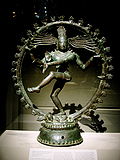Background
This section possibly contains original research .(December 2024) |
The 48-days July–August annual Hindu pilgrimage, undertaken by up to 600,000 or more pilgrims to 130 feet (40 m) high glacial Amarnath cave shrine of iced stalagmite Shiv linga e at 12,756 feet (3,888 m) in Himalayas, is called Amarnath Yatra . [5] [6] [7] It begins with a 43 kilometres (27 mi) mountainous trek from the Nunwan and Chandanwari base camps at Pahalgam and reaches cave-shine after night halts at Sheshnag Lake and Panchtarni camps. [8]
The yatra is both a way of earning revenue by the state government by imposing tax on pilgrims, [9] [10] and making living by the local Shia Muslim Bakarwal-Gujjars [ citation needed ] by taking a portion of revenue and by offering services to the Hindu pilgrims, and this source of income has been threatened by the militant groups who have banned and attacked the yatra numerous times, [11] [12] [13] [14] [15] as well as have massacred at least 30 and injured at least 60 people in Amarnath pilgrimage terrorist-attack massacre (2000) causing the deaths of 21 unarmed Hindu pilgrims, 7 Muslim civilians and 3 security forces in a two hour long indiscriminate shoot out at Pahalgam town in Anantnag district. [2]
This attack on Amarnath yatra was part of the larger 1st and 2nd August 2000 Kashmir massacre in 5 separate coordinated terrorist attacks that killed at least 89 (official count) to 105 people (as reported by PTI), and injured at least 62 more. [16]
